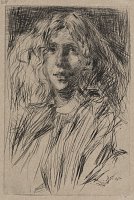Etchings Institutions search term: british museum
Jo | ||
| Number: | 87 | |
| Date: | 1861 | |
| Medium: | drypoint | |
| Size: | 227 x 152 mm | |
| Signed: | 'Whistler.' at lower right | |
| Inscribed: | '1861.' at lower right | |
| Set/Publication: | 'Cancelled Plates', 1879 | |
| No. of States: | 1 | |
| Known impressions: | 25 | |
| Catalogues: | K.77; M.77; T.60; W.64 | |
| Impressions taken from this plate (25) | ||
PUBLICATION
 ,
,  ).
).EXHIBITIONS
 ) and 'The plate destroyed.' (
) and 'The plate destroyed.' ( ) 7
) 7
. It was shown at the World's Columbian Exposition in Chicago in 1893, and by H. Wunderlich & Co. in New York in 1898, at which time an impression was bought by Charles Lang Freer (1856-1919) (
 ). 8 Another impression was lent by Howard Mansfield (1849-1938) to the show organised by the Caxton Club, Chicago in 1900 and to a major loan exhibition in Philadelphia in 1902 (
). 8 Another impression was lent by Howard Mansfield (1849-1938) to the show organised by the Caxton Club, Chicago in 1900 and to a major loan exhibition in Philadelphia in 1902 ( ). 9
). 9
After Whistler's death, Mansfield again lent his impression to the Boston Memorial in 1904, and another impression was shown at the Memorial exhibition in London in 1905. 10
6: Liverpool 1874 (cat. no. 522). See REFERENCES : EXHIBITIONS.
7: New York 1881 (cat. no. 91).
8: New York 1898 (cat. no. 61).
9: Chicago 1900 (cat. no. 59); Philadelphia 1902 (cat. no. 947 (064)).
10: Boston 1904 (cat. no. 57); London Mem. 1905 (cat. no. 64).
SALES & COLLECTORS
11: Wedmore 1886 A (cat. no. 64).
12: Glasgow Herald, 6 May 1890.
 ). Whistler himself thought the drypoint was valuable partly because of its rarity. In a letter written to Joseph Pennell (1860-1926) he compared the possible price to that of The Forge
[86]:
). Whistler himself thought the drypoint was valuable partly because of its rarity. In a letter written to Joseph Pennell (1860-1926) he compared the possible price to that of The Forge
[86]: 13: [13 March 1894], GUW #07787.
 ) passed to Harris G. Whittemore (d. ca 1937) and was eventually given by Lessing Julius Rosenwald (1891-1971) to the National Gallery of Art, Washington, DC.
) passed to Harris G. Whittemore (d. ca 1937) and was eventually given by Lessing Julius Rosenwald (1891-1971) to the National Gallery of Art, Washington, DC.14: Mansfield 1909 (cat. no. 77).
 ) as well as a striking impression of the first state (
) as well as a striking impression of the first state ( ). Charles Lang Freer (1856-1919) acquired one that was originally from the collection of Francis Seymour Haden, Sr (1818-1910), from Wunderlich's in 1898 (
). Charles Lang Freer (1856-1919) acquired one that was originally from the collection of Francis Seymour Haden, Sr (1818-1910), from Wunderlich's in 1898 ( ).
). ). The British Museum acquired a set in 1887 (
). The British Museum acquired a set in 1887 ( ). Another set sold at the Alphonse Wyatt Thibaudeau (ca 1840- d.1892) sale, Sotheby's, London, 13 December 1889 (lot 787 or 789), and was bought by another print dealer Robert Dunthorne (b. ca 1851) for £0.6.0; it was later acquired in exchange for other artworks by Rosalind Birnie Philip (1873-1958), who bequeathed it to the University of Glasgow in 1958 (
). Another set sold at the Alphonse Wyatt Thibaudeau (ca 1840- d.1892) sale, Sotheby's, London, 13 December 1889 (lot 787 or 789), and was bought by another print dealer Robert Dunthorne (b. ca 1851) for £0.6.0; it was later acquired in exchange for other artworks by Rosalind Birnie Philip (1873-1958), who bequeathed it to the University of Glasgow in 1958 ( ). Charles Lang Freer (1856-1919) bought a set from Knoedler & Co. in 1893 (
). Charles Lang Freer (1856-1919) bought a set from Knoedler & Co. in 1893 ( ).
).
